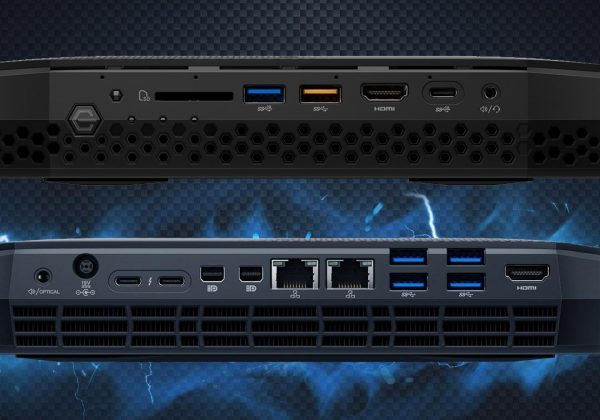The latest version of Intel’s miniscule ‘NUC’ PC is VR capable, the company says. Thanks to the power of AMD’s discrete Radeon Vega M graphics, the new NUC can power “premium” VR experiences at 90 FPS, says Intel.
Announced at the start of this week’s CES 2018, Intel has debuted a new version of its NUC computer line of tiny enthusiast PCs. The new NUC8i7HVK model comes equipped with the 8th Generation Intel Core i7-8809G with discrete Radeon RX Vega M GH graphics attached directly to the CPU. The two companies, which have been longstanding rivals, announced last year that they would begin collaborating on CPU/GPU products; the first fruits of that joint effort—Intel CPUs with on-board AMD graphics—were revealed here at CES 2018.

Intel claims the new NUC is the “smallest VR capable system ever,” at just 1.2 litres in volume (221 x 142 x 39 mm). Based on the information provided by the company—which says the system is capable of 90 FPS VR gaming—we take that to mean the PC meets the typical ‘VR Ready’ specifications adopted by Oculus, HTC, and others, though the claim is not well specified by the announcement. We’ve reached out to Intel for clarity.
Intel NUC8i7HVK Specifications
- CPU/GPU
- 8th Generation Intel® Core™ i7-8809G
- 3.1 GHz to 4.2 GHz Turbo, Quad Core, 8 MB cache, 100W
- Radeon™ RX Vega M GH graphics, 1063 MHz – 1190 MHz
- Unlocked [for overclocking]
- RAM
- Dual channel DDR4-2400+ SODIMMs, 1.2V, 32GB maximum
- M.2 & SDXC
- 2x M.2 22×42/80 (key M) slots for SATA3 or PCIe x4 Gen3 NVMe or AHCI SSD, RAID-0 and RAID-1 capable
- SDXC slot
- Connectivity
- 2x rear Thunderbolt™ 3 (40 Gbps) and USB 3.1 Gen2 (10 Gbps) and DisplayPort 1.2 via USB-C™ connector
- Front USB 3.1 Gen2 via USB-C™ and front USB type-A connector
- Front charging USB 3.0, 4x rear USB 3.0, 2x internal USB 3.0 and 2x USB 2.0 via headers
- Front Consumer Infrared port
- Video Outputs
- Front and rear HDMI 2.0a (4K 60Hz, HDR) connectors
- DisplayPort 1.3 via 2x rear Mini DisplayPort ports, and 2x rear Thunderbolt™ USB-C™ ports
- All ports support HDCP 2.2
- Networking
- 2x Intel® 10/100/1000 Mbps (i219-LM and i210-AT) Ethernet ports
- Intel® Wireless-AC 8265 M.2 22×30 card, IEEE 802.11ac 2×2 + Bluetooth v4.2, internal antennas
- Audio
- Up to 7.1 multichannel digital audio via HDMI or DisplayPort signals
- 3.5mm front headset jack, 3.5mm rear speaker / TOSLINK combo jack
- Internal Headers
- Common I/O header with Front Panel, CEC, 2x USB 3.0, 2x USB2.0 signals
Pricing hasn’t yet been announced, though the company says the systems will become available starting in the Spring. Prior NUC devices have ranged in price from $200–$900, though this time around Intel says the new NUC will be “sold as bare-bones kits, targeted to DIYers who are looking for small, sleek and powerful mini PCs,” which sounds decidedly more ‘premium’ than how the NUC line was positioned in the past.










